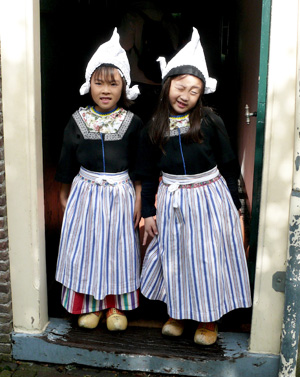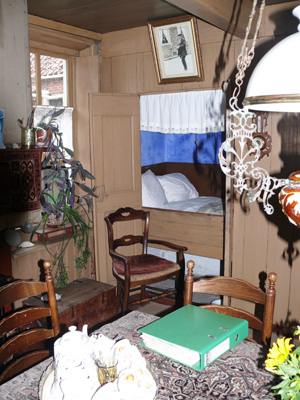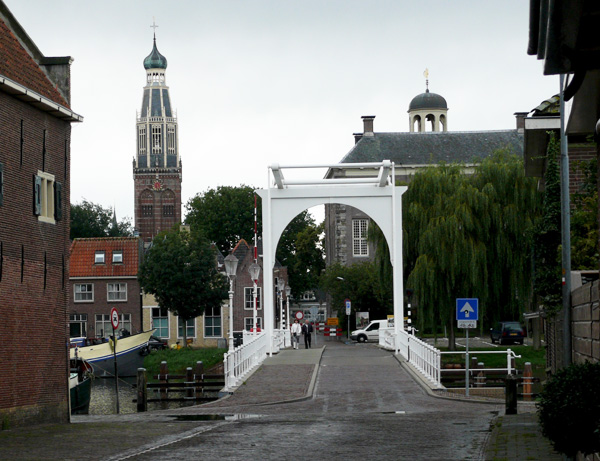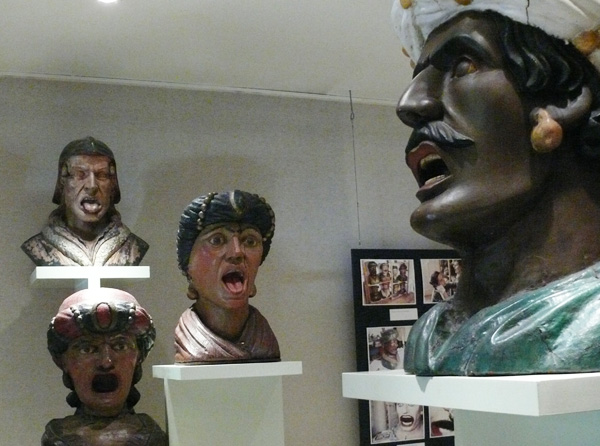ENKHUIZEN, THE NETHERLANDS - Two, cute little Chinese girls run to the front door of a pioneer home dressed in traditional Dutch costumes, complete with Flying Nun bonnets, and ask their mother take a photograph.
“Look mommy,” says one of the girls in Mandarin, “we’re Dutch girls now.”
People from all around the world come to this quaint Dutch village located an hour’s drive north of Amsterdam to get a sense of what life was like in this land-challenged country back in the early part of the 20th century – when much of the Netherlands was still under water. And the pioneer village known as the Zuiderzee Museum, painstakingly recreated in Enkhuizen using a collection of homes and buildings once located in the coastal Zuiderzee, provides them with just such insight.
The Zuiderzee, where people made their living off the sea, dried up with the construction of a long barrier dam completed in 1932, and the land reclamation project that followed saw fishing diminish; saltwater turn into fresh water; water become land; and an entire way of life vanish. The people of the Zuiderzee moved off their islands and into cities and towns. And many of their homes were brought here so that the story of the Zuiderzee could be preserved for future generations.


Above: Visitors dress up like little Dutch girl at the open-air Zuiderzee Museum.
There is still much life in the open-air Zuiderzee Museum today, thanks to the dozens of tourists and local school children who come here each day to see the neatly-kept homes and shops that make up this impressive complex, which even has its own windmill and canal. Actors in pioneer costumes take on the role of the Zuiderzee people – right down to doing everyday choirs like house cleaning, laundry and shoeing horses in the blacksmith’s shop – and that gives visitors an authentic look into what challenges the rugged people of that area faced back in the early 1900s.
The Chinese family is joined by others hoping to get pictures of their children decked out in the traditional dress of the Zuiderzee folk – females of all ages wore long dresses and lace bonnets while men dressed in long sleeved shirts, suspendered trousers and hats. A shop in the pioneer village allows children to get dressed in period costumes and the kids wander around town, stopping in the small village square where they play the simple games of bygone times.
The museum village is divided into a number of districts or neighbourhoods. Buildings that came from the same town are usually grouped together at the open-air museum and the houses are authentic, right down to the furniture – many of the original owners provided specifics on how their homes were decorated when they stood in the Zuiderzee.
As we wander the tree-shaded streets of the open-air museum, we come upon two men – one is making sails and the other huge nets. Sail makers were very important in the Zuiderzee, where people made their living off the sea. The net maker shows us how the nets were boiled in a process called tanning, - a disinfecting, decay-resistant and preserving brown-yellow liquid to help preserve them. After boiling for about three hours, the nets are hung to dry. The introduction of synthetic nets killed the tanning industry.

Above: City's old draw bridges and ancient church towers inspire a lot of pictures.
The museum’s Church District, featuring a lovely red-brick church, has been reconstructed based on plans of a former Zuiderzee village called Hindeloopen. An old post office and sweet shop – visitors line up for candy samples here – and a former Zuiderzee school house are also landmarks in this area.
Visiting one of the original Zuiderzee homes is a thrill. The inhabitants were not poor but their homes were small. One of the most interesting features of the houses is their “closet bedrooms”, which were actual closets where whole families slept.
Mothers and fathers and the youngest children slept in a large angled bed – the Zuiderzee people believed it much healthier to sleep on an angle for proper blood circulation – at the top level of the closet and the rest of the family slept in crawl spaces under the parents’ bed.
Outside the village pharmacy, passersby are struck by the open-mouthed bust of a man wearing a crown.
“The open-mouth indicates that this is a pharmacy and that the owner has studied to be a pharmacist,” says Yvonne, a guide at the museum. “It was very important back then because there were many fakes. The open-mouth is supposed to represent someone taking medicine.”
Inside the pharmacy, more busts hang and some of them can be very scary.
The village cheese house, which once stood in Landsmeer, is where visitors sample great Dutch varieties like Gouda and Edam. Few pass up the opportunity to buy large blocks to take home.
The old smoke house, where fishermen would preserve their catches of herring, eel and mackerel for the long winters in the Zuiderzee, is still working and people line up for samples of kippers. The smell makes us hurry past. As we enter the steam laundry, run by an old steam engine, a man stoking the fire wipes sweat off his forehead and explains that the steam turns large washer drums – they look remarkably like the latest Maytag – and afterwards clothes were hung in drying attics or on the bleaching field.
“This was back breaking work and as you can feel, the heat is almost unbearable,” says the volunteer attendant. “The steam laundry involved much lifting and the floor was always slippery – so many accidents occurred.”
The museum village even has its own dike – a reminder of how those living in the Low Countries of Holland were in a permanent fight against rising water.
A replica of the harbour from Marken, another island that formed the Zuiderzee, is filled with tiny wooden fishing craft, the type that the inhabitants of that area relied so much on for their livelihoods.

Above: The 17th century Dutch used some creative ways to showcase medial issues.
A walk around quaint Enkhuizen afterwards reveals it to be as interesting as the pioneer village. Its grand harbour, now filled with sleek modern yachts, and the well-preserved 16th and 17th century homes that line its streets and main canal, indicates Enkhuizen must have been an important place at one time.
“Very important,” says Marianne, a local woman who loves showing visitors around a city that was established in 1355.
“Enkhuizen was very prosperous because the East and West India companies. In fact, Enkhuizen was the fifth largest town in Holland at one time with 22,000 people living here,” says Marianne, who reveals the population has dwindled to about 17,000 now.
The former cold-storage warehouse used by the East and West India companies now serves as the impressive Enkhuizen Almanak Museum and its displays, especially those showing off ancient seagoing vessels, are very impressive.
A walk across the Drommedarisbrige brings us to a street called Dijk, which is lined with excellent examples of home styles from the 18th century - the most impressive being No. 34, the Snouck van Loosen house once owned by a very rich merchant whose last heir left the remainder of the family fortune to the poor.
The town’s canal also served as its first harbour and was constructed in 1361 as a safe haven for small ships coming from the rough waters of the Zuiderzee, where many a ship was lost during violent storms.
A little further along, we come to the Markermeer locks, the busiest in the Netherlands thanks to the pleasure boats that come from all over the country to this town with the rich nautical history.
Another handsome building is the Peperhuis (pepper house) where the East and West India companies stored their precious cargo of pepper.
The brick façade of the old town prison is only a cover for the real oak skeleton, which is the nucleus of a place where cutthroats and thieves were sent to the gallows.
The Town Hall, main church, the Waag (weigh house) and collection of buildings and shops along Westerstraat (Enkhuizen’s main street) combine to make a walking tour of this idyllic town very memorable.